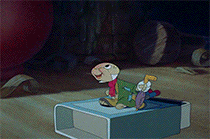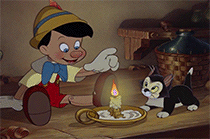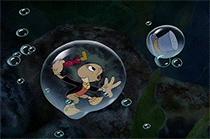In one respect, Pinocchio was a failure. The 1940 follow-up to Walt Disney’s world-beating Snow White And The Seven Dwarfs—which proved in 1937 that feature-length animated movies were not only possible, but could be profitable as well—Pinocchio cost more than twice as much as its predecessor, and made back only half its production costs in its initial theatrical run. (A 1992 re-release made considerably more, but by that time the film had already been entrenched as a classic in the popular imagination.) But creatively, Pinocchio represents the apex of the Disney Feature Animation brand, a project of wild ambition that consumed Walt Disney and his team for two years, and firmly established feature animation as a legitimate art form on the same level as traditional filmmaking.
Which isn’t to say Snow White wasn’t an artistic achievement of monumental proportions—it was and will always be the first cel-animated feature, and the chutzpah and innovation required to make it happen cannot be understated. And the years immediately following its successful release involved a flurry of activity for the company that resulted in a string of early classics, including Fantasia, Dumbo, and Bambi, which were all released within a year of one another. But Pinocchio was and is the true marvel of Disney Feature Animation’s first half-decade. It’s a lush, expensive labor of love that found Disney and his animators—including the young whippersnappers who went on to become the company’s storied “Nine Old Men”—developing and refining the techniques that would define Disney, and in many cases non-Disney, animation for years to come.
And so, as we approach Pinocchio’s 75th anniversary next February, let’s take a look back at some of the achievements, innovations, and techniques that set the standard Disney has worked to meet ever since—and arguably never has.
As memorable as Snow White’s character design is—particularly in its discrete, distinguishable seven dwarves—all of its acting characters are humanoid, which meant animators could reference human models, or even themselves, when animating their movement. That wasn’t the case with Pinocchio, which adds a wooden puppet, a cricket sidekick, magical donkey-boys, and some animal-kingdom flim-flam men to its otherwise-human cast. Disney shorts had a long history of non-humanoid characters, but blowing that kind of design up to feature-sized and -length proportions meant Walt Disney and his team of artists had to think beyond what the characters were supposed to represent, and consider what emotional effect they would have on the audience.
Pinocchio himself was the first and greatest challenge of character design. In Carlo Collodi’s original Italian serial novel, Pinocchio was a mean-spirited wooden boy, which meant that in addition to altering his personality to that of an impressionable wide-eyed naif, Disney and Co. had to find a way to make him visually appealing as well. Disney was unhappy with early attempts at the character, which he felt were too puppet-like and unrelatable. He halted production to reconfigure his star. It was animator Milt Kahl who focused on drawing Pinocchio as a little boy rather than a puppet, with only his nose and angular posture indicating his wood-carved origins. Kahl’s model for the character eventually became the little wooden-head we all know and love today.

Jiminy Cricket provided a separate challenge for animator Ward Kimball, whom Disney tasked with creating a cute, lovable sidekick out of what Kimball initially saw as “an ugly insect.” In retrospect, it’s fairly astonishing that Disney and Kimball were able to take a creepy, moralizing minor character from Collodi’s story—one Pinocchio kills with a mallet—and turned him into the company’s first and most durable animal sidekick, one who functioned as the Walt Disney Company’s secondary mascot (after Mickey) for years. There’s nothing particularly insect-like about the finalized Jiminy, outside of the broad planes of his face—even his antennae look more like hair than a piece of insect anatomy—but it took Kimball several attempts to land there. Just as with Pinocchio, the answer lay not in what the character physically represents, but how audiences should respond to that character. Jiminy is a figure of friendship, steadfastness, and warmth, and his design reflects that, from his big, trusting eyes to his perpetually forward-leaning posture. Subsequent Disney sidekicks, from Cinderella’s mice to Belle’s castle-decor buddies, extended and expanded this function-over-form approach to character design.
Bring up Pinocchio with animation buffs, and they’ll likely gush about the effects animation. From the Blue Fairy’s twinkling wand and flickering candles to the awe-inspiring water effects in the climactic Monstro chase, Pinocchio is filled with hand-drawn effects that had never even been attempted before, much less executed with such aplomb. Even something as simple as Figaro’s whiskers and shading, done with white chalk flourishes atop the painted cels, represent a forward-thinking approach to the fine-tuned details that bring animation to life.
 |  |
 |  |
But the water effects are the true standout in Pinocchio, representing an artistic achievement that would still be difficult to replicate today. To a certain extent, it was nothing more complicated than good old fashioned hard work: Effects animator Sandy Strother worked on nothing but water effects for a full year. But in addition to working hard, the animators were working smart: In the open-water scenes, for example, the water toward the back of the frame is less detailed and more impressionistic, allowing the artists to focus on making the foreground as rich in detail as possible.
But as detailed as that water is, it isn’t attempting photorealism; as with the character design, the focus is on how the water should function within the story and the emotional response it should provoke, not replicating the real world exactly. Compare the down-to-the-droplet detail of Pinocchio’s open-water scenes to those of Fleischer Studios’ first entry in the feature-animation game, Gulliver’s Travels. Released only a few months before Pinocchio, Gulliver’s Travels used rotoscoping, which had been developed at Fleischer. While the film’s water looks realistic and imposing, it has a flat, almost geometric look that undermines its visual punch. Whereas the way the water works as Monstro chases Geppetto and Pinocchio’s raft is terrifying and overwhelming, and not especially realistic. This is the power of animation, to mold and morph reality to function as something familiar, yet fantastical.
Two-dimensional model sheets were used on Snow White and other earlier Disney efforts to maintain consistency among characters who were animated by multiple artists. But Pinocchio took that standard to the next level with a method that’s still employed today in both hand-drawn and computer-aided animation: sculpted three-dimensional models. Having miniature—or in some cases, to-scale—sculptures of the film’s many moving elements meant animators could switch gears more easily between projects, and maintain consistency of form and proportion across multiple sequences.
In addition to the secondary character models and Pinocchio himself—overseen by Bob Jones, a puppeteer who came to Walt Disney hoping to convince him to make a three-dimensional puppet movie—the modeling department created detailed miniatures of Stromboli’s wagon, the Pleasure Island stagecoach, and, perhaps most astonishingly, working models of the many whimsical cuckoo clocks that hang on Geppetto’s workshop wall, so animators could see how the fanciful creations actually looked in motion. In the case of Stromboli’s wagon, the working miniature, complete with suspension system, was actually filmed from the angles the animators needed, and then that footage was combined with the animation, in order to accurately mimic the wagon’s quality of movement.
Disney loved the three-dimensional models, and he expanded the studio’s Character Model shop in the early 1940s, bringing in more sculptors to work on models for Bambi, Fantasia, and other productions. Although the model shop was disbanded in the mid-1940s as a cost-saving measure during World War II, Disney and his company continued the practice in a more informal capacity over the years on films like Cinderella and 101 Dalmatians. And when the time came, in the early 1950s, for Disney to sell his groundbreaking idea of an immersive entertainment experience to investors and consumers, what did he turn to? Why, models, of course.
Disney had been experimenting with the multiplane camera since developing it in the early 1930s, and it was used some on Snow White, but Pinocchio saw him pushing the limits of what his creation could do further than ever before. Virtually every shot in the film uses the multiplane technique, which divides the different elements of a shot into several levels—background, detail, character, effects, etc.—of a huge camera rig that allows each “plane” to be run through the camera and filmed at different speeds. As one small but beautiful example, the sequence where the Blue Fairy visits Pinocchio when he’s trapped in Stromboli’s birdcage is filmed in multiplane, with the outline of the carriage bobbing in the foreground, and the light of the fairy moving toward the camera, illuminating the interior; animating that the traditional way, frame by frame, would be laborious to the point of insanity.
But the most impressive use of the multiplane camera in Pinocchio, and one of the most impressive in all of animation, is the 45-second pan over the village the morning after Pinocchio is brought to life. It’s a marvel to see even today, as the camera pans down, across, and through the buildings while children run in and out of the frame, every inch bursting with detail and depth. This remarkable effect was achieved by moving the planes of the camera horizontally as well as vertically, mimicking the effect of a swooping overhead crane shot. It’s proof that animation can be every bit as dynamic and screen-filling as live-action, sometimes even more so.
Casting well-known names as character voices didn’t become the norm in animated features for several more decades, and Disney has never relied as much on that aspect of its casting as other animation companies. But Disney bringing in Cliff Edwards as the voice of Jiminy Cricket represents an important shift in how the industry approached voice work. Previously, professional voice actors and behind-the-scenes figures provided the voices for animated characters; Walt Disney himself provided Mickey Mouse’s voice for years. But Edwards was a well-known musician well before he crooned “When You Wish Upon A Star”: He made his name on vaudeville and in early sound pictures, and as “Ukulele Ike,” whose hit records reportedly sold somewhere in the realm of 74 million copies over the years. And while Edwards was nowhere near the first choice for the voice of Jiminy—in part because by the time the late 1930s had rolled around, his career had stalled and he was battling alcoholism—once he was cast, he became inseparable from the character. The animators were inspired by his physical presence while he was singing and acting, and there’s more than a little Edwards in the final onscreen representation of Jiminy.
Similarly, Christian Rub, the prolific character actor who voiced Geppetto, served as the visual basis for his character, as did Evelyn Venable for the Blue Fairy. (Trivia: Venable was also the first model for Colombia Pictures’ “torch lady” logo.) While none of these figures are likely familiar to modern audiences, their names, and especially their faces, were certainly known by 1940 viewers, making the visual link between the characters and the actors more significant, even if only on a subliminal level: Rub wasn’t credited in the film, but the version of Geppetto we know is more or less him exactly, from the accent (his own), to his body language, which animators used as a visual reference. As with the increased use of 3-D modeling, the incorporation of actors’ physicality and personality into their characters help ground Pinocchio in an established reality, allowing for the creation of a fantastical world that feels real.
Music was always an integral part of Disney’s approach to animation, going back to the Silly Symphony shorts, whose approach to integrating music with animation would be realized on a large scale a few months after Pinocchio’s release with Fantasia. And Snow White set the standard for including musical numbers in animated films, as well as for releasing a soundtrack album to accompany the film, which was unheard of at the time. But it was Pinocchio and “When You Wish Upon A Star” that netted Disney the Academy Awards for Best Original Score and Best Original Song, the first animated feature to win both in a year. (Despite its best efforts, the company didn’t duplicate that feat until 1964 with Mary Poppins, and then not again until The Little Mermaid.) In addition to setting a new bar for the type of music the company was producing—and the types of awards it could win with it—“When You Wish Upon A Star” became Disney’s de facto theme song, and established Disney songs as entities capable of living on in the pop-cultural consciousness beyond the movies that introduced them.
Most of the elements and techniques Disney used in Pinocchio weren’t completely new—Disney regularly used its short films as proving grounds for things like the multiplane camera—but they were untested at Pinocchio’s level. And that represents perhaps the film’s greatest achievement: unprecedented artistic ambition. From the macro level—making major alterations on the story and character levels—to the micro—spending a full year animating water droplets—the production of Pinocchio represents a calculated risk that established Disney Feature Animation as an artistic force as well as a commercial one. Snow White set the records, but Pinocchio set the standard.
Nathan Rabin and Tasha Robinson continue the conversation in the Movie Of The Week Forum with a look at Pinocchio’s lonely tone, moral lessons, and surprisingly sophisticated terrors, plus Jiminy Cricket’s carved-wooden-skirt-chasing. And on Thursday, Noel Murray will cap the discussion with a look at seven pre-Pinocchio cartoons that represent “the old, weird Disney.” Stay tuned.

